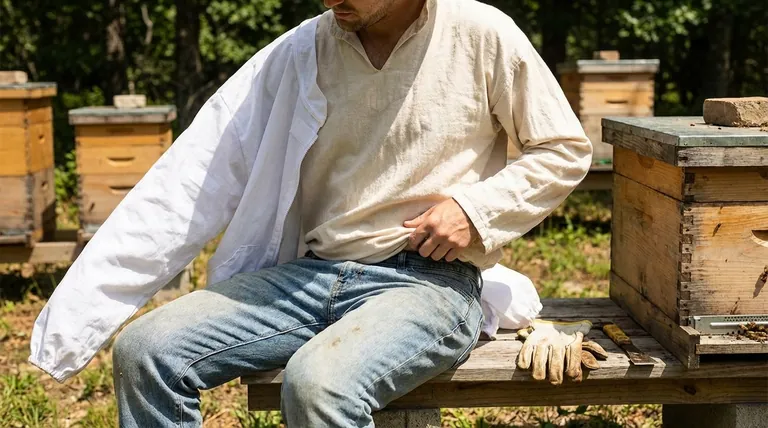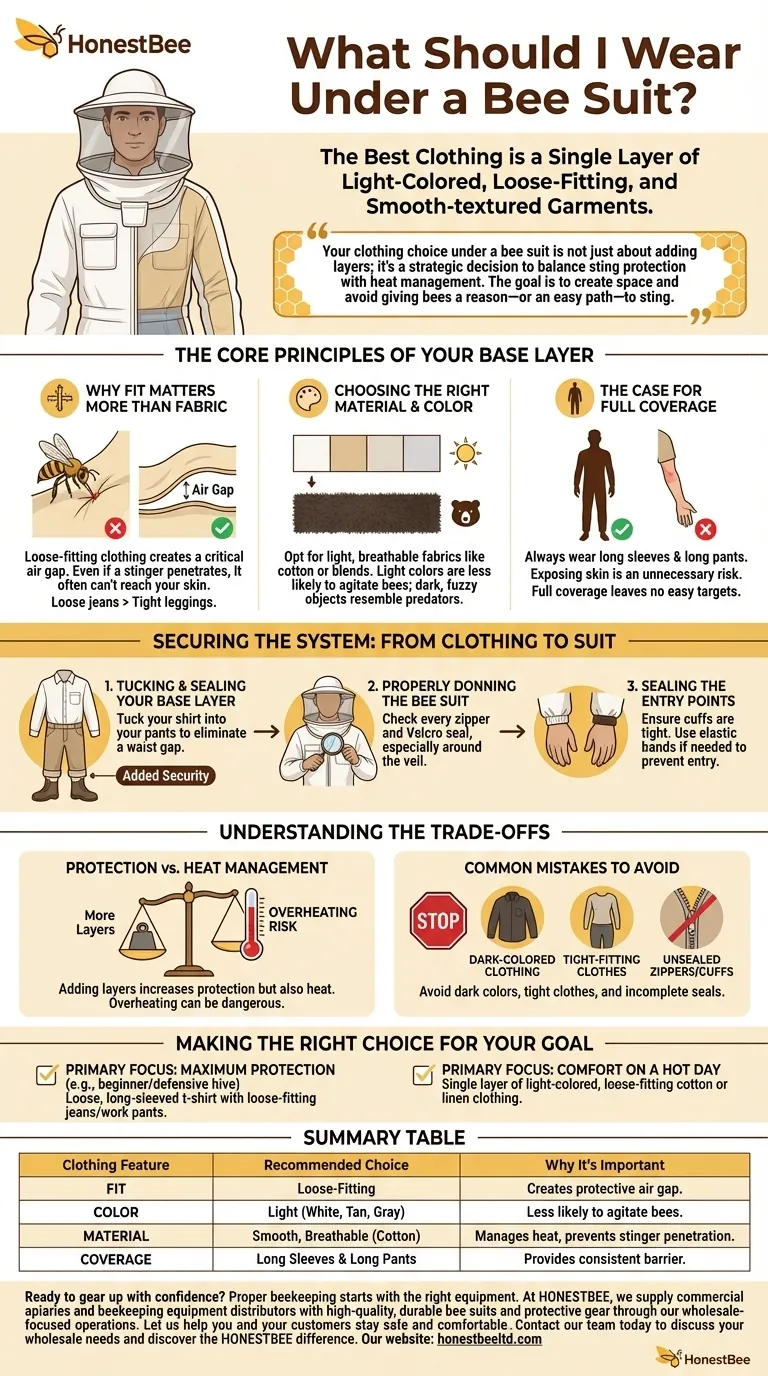The best clothing to wear under a bee suit is a single layer of light-colored, loose-fitting, and smooth-textured garments. Think long-sleeved cotton shirts and loose-fitting jeans or canvas pants. This approach creates a critical air gap between the suit and your skin, providing both protection and comfort.
Your clothing choice under a bee suit is not just about adding layers; it's a strategic decision to balance sting protection with heat management. The goal is to create space and avoid giving bees a reason—or an easy path—to sting.

The Core Principles of Your Base Layer
What you wear underneath your suit serves as your secondary defense system. Its effectiveness depends on three key factors: fit, color, and coverage.
Why Fit Matters More Than Fabric
The single most important principle is to wear loose-fitting clothing. A baggy shirt and pants create an air gap between the material and your skin.
Even if a bee's stinger penetrates the outer suit, it is often too short to cross this gap and reach you. This is why loose jeans are a far better choice than tight-fitting athletic leggings.
Choosing the Right Material and Color
Opt for fabrics that are light and breathable, like cotton or a cotton blend. This helps manage heat, as working in a bee suit on a sunny day can quickly lead to overheating.
Wear light colors like white, tan, or light gray. Bees are naturally defensive against dark, fuzzy objects that resemble predators like bears. Light, smooth clothing is less likely to trigger an aggressive response.
The Case for Full Coverage
Always wear long sleeves and long pants. Exposing any skin under the suit is an unnecessary risk. A bee that finds its way inside your suit will seek out any available skin.
Full coverage ensures a consistent barrier, leaving no easy targets.
Securing the System: From Clothing to Suit
Properly wearing your clothes and suit is just as important as choosing them. A determined bee can exploit the smallest gap.
Tucking and Sealing Your Base Layer
Before putting on your bee suit, tuck your shirt into your pants. This simple step eliminates a major gap at your waist where a bee could crawl upwards.
For added security, you can also tuck your pants into your socks or boots. This creates a continuous, sealed inner layer.
Properly Donning the Bee Suit
Once your base layer is secure, put on your suit and check every zipper and Velcro seal. It's common for zippers, especially around the veil, to have small gaps if not closed completely.
Run your fingers along all closures to ensure they are fully sealed before you approach a hive.
Sealing the Entry Points
Your suit's cuffs are critical entry points. Most suits have elastic at the wrists and ankles, but if yours doesn't, use elastic bands to create a tight seal. This prevents bees from crawling up your arms or legs.
Understanding the Trade-offs
Choosing what to wear involves balancing competing priorities. There is no single perfect answer for every person in every climate.
Protection vs. Heat Management
Adding more layers technically increases protection, but it comes at a significant cost: heat. Overheating is a serious risk and can lead to dizziness, poor decision-making, and heat exhaustion.
In most situations, a single, well-chosen loose layer provides sufficient backup protection without causing you to overheat. A comfortable beekeeper is a calm and safe beekeeper.
Common Mistakes to Avoid
The most frequent errors come from prioritizing convenience or fashion over function. Avoid wearing dark-colored clothing, which can agitate bees.
Steer clear of tight-fitting clothes like yoga pants or compression shirts, as they eliminate the protective air gap. Finally, never assume your suit is perfectly sealed without double-checking all zippers and cuffs.
Making the Right Choice for Your Goal
Your ideal base layer depends on your personal comfort with bees and your local climate.
- If your primary focus is maximum protection (e.g., you're a beginner or working with a defensive hive): Wear a loose, long-sleeved t-shirt with loose-fitting jeans or work pants.
- If your primary focus is comfort on a hot day: A single layer of light-colored, loose-fitting cotton or linen clothing is your best choice for staying cool and protected.
Ultimately, wearing the right clothes under your suit allows you to feel secure, stay comfortable, and focus your attention on the health of your bees.
Summary Table:
| Clothing Feature | Recommended Choice | Why It's Important |
|---|---|---|
| Fit | Loose-Fitting | Creates a protective air gap between fabric and skin. |
| Color | Light (White, Tan, Gray) | Less likely to agitate bees compared to dark colors. |
| Material | Smooth, Breathable (Cotton) | Manages heat and prevents stinger penetration. |
| Coverage | Long Sleeves & Long Pants | Provides a consistent barrier with no exposed skin. |
Ready to gear up with confidence?
Proper beekeeping starts with the right equipment. At HONESTBEE, we supply commercial apiaries and beekeeping equipment distributors with high-quality, durable bee suits and protective gear through our wholesale-focused operations.
Let us help you and your customers stay safe and comfortable. Contact our team today to discuss your wholesale needs and discover the HONESTBEE difference.
Visual Guide

Related Products
- Economy Polyester Beekeeping Jacket with Veil and Hat
- Beekeeping Jacket with Hood and Veil for Beekeepers
- Cotton Beekeeping Suit and Round Hat with Veil Bee Keeper Protective Gear
- White Beekeeping Protective Suit and Hat with Fencing Veil for Beekeepers
- Heavy Duty Cowboy Beekeeper Hat with Visibility Veil Outdoor Professional Beekeeping Protective Gear
People Also Ask
- What are the advantages of using a beekeeping jacket instead of a full suit? Unlock Speed and Comfort
- What is a bee jacket and how does it differ from a full beekeeping suit? Choose the Right Protection for Your Apiary
- What are the advantages of a beekeeping jacket? Superior Mobility & Comfort for Routine Hive Inspections
- What are the main types of protective clothing worn by beekeepers? Choose the Right Gear for Maximum Safety
- What are the pros of using a beekeeping jacket? Unlock Superior Comfort and Mobility for Your Apiary



















